Cooking With Liquid Nitrogen: Tips and Safety Precautions
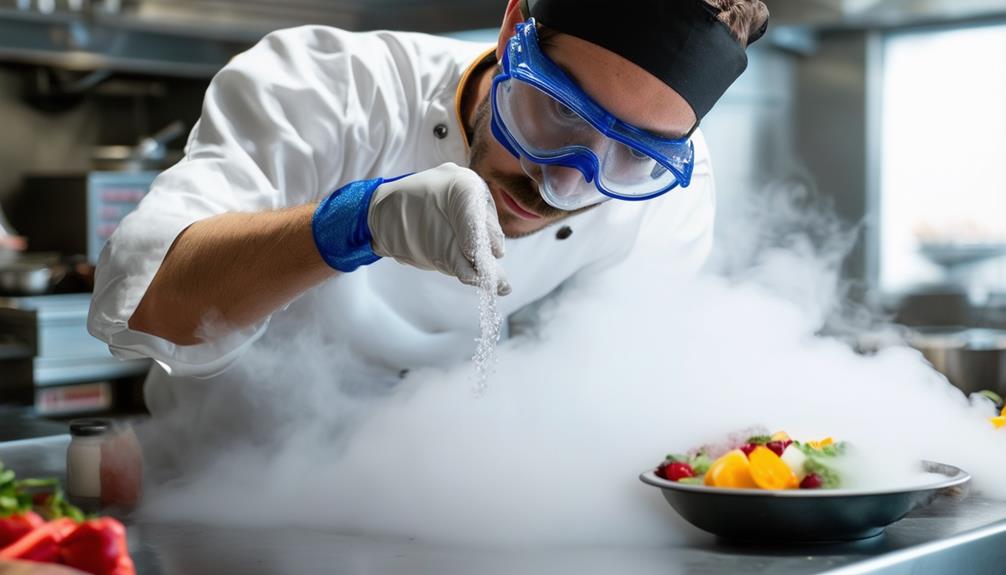
When considering the use of liquid nitrogen in cooking, prioritizing safety is essential. Wear appropriate protective gear, such as cryogenic gloves and safety glasses, to protect yourself from potential hazards.
Store liquid nitrogen in well-insulated containers and ensure good ventilation. Beginners should start with simple recipes to master the basics and avoid common mistakes.
Ready to handle this fascinating element safely and effectively in your kitchen?
Key Takeaways
Cooking With Liquid Nitrogen: Tips and Safety Precautions
- Wear Protective Gear: Always wear cryogenic gloves, safety glasses, and protective clothing to prevent frostbite and injuries.
- Use Well-Ventilated Areas: Work in a well-ventilated space to avoid the risk of suffocation from nitrogen gas buildup.
- Proper Storage: Store liquid nitrogen in high-quality, insulated, and vented containers to maintain low temperatures and prevent leaks.
- Avoid Airtight Containers: Never seal liquid nitrogen in an airtight container to prevent pressure buildup and potential explosions.
- Ensure Complete Evaporation: Allow liquid nitrogen to fully evaporate from food before serving to avoid ingestion risks and ensure safety.
Understanding Liquid Nitrogen
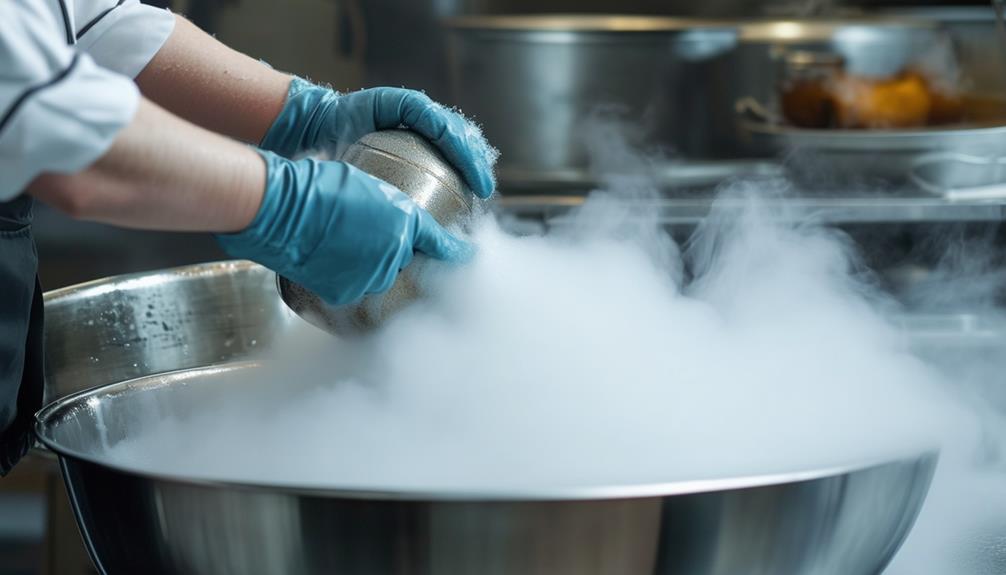
Understanding liquid nitrogen begins with recognizing that it's nitrogen in a liquid state at the extremely low temperature of -196 degrees Celsius. This substance is crucial in the culinary world for flash-freezing foods, creating unique textures, and preserving flavors and nutrients that might otherwise be lost with slower freezing methods.
Liquid nitrogen is produced through fractional distillation of liquid air. This process involves cooling air to separate nitrogen from other gases by their respective boiling points, resulting in pure liquid nitrogen. It's fascinating how science and cooking intersect so dramatically.
Handling liquid nitrogen requires caution. Direct contact with skin can cause severe frostbite, and ingestion can lead to serious internal injuries. While the dramatic smoky effect it produces can enhance any dish, safety is paramount.
Understanding liquid nitrogen's properties and production provides a solid foundation for safe and effective use in culinary applications.
Essential Safety Gear
When handling liquid nitrogen, it's essential to use specific safety gear to prevent injuries.
Always wear cryogenic gloves to protect against frostbite and safety glasses to shield your eyes from potential splashes.
Ensure you're working in a well-ventilated area to minimize the risk of asphyxiation.
Protective Clothing Requirements
To safely handle liquid nitrogen in cooking, essential protective gear includes cryogenic gloves and safety glasses. When working with extreme cold, protective clothing is your primary defense.
Cryogenic gloves are specifically designed to prevent frostbite, ensuring your hands stay safe from temperatures as low as -196°C. These gloves are crucial because even brief contact with liquid nitrogen can cause severe burns.
In addition to gloves, proper attire is necessary. Long sleeves and closed-toe shoes are mandatory, as they help minimize skin exposure and protect against accidental splashes or spills. Everyday clothing is insufficient; specialized protective clothing ensures you're adequately shielded from the risks.
Adequate ventilation in your cooking area is also important. Liquid nitrogen rapidly converts to gas, and without proper airflow, nitrogen gas can accumulate, posing a suffocation hazard. Ensuring good ventilation helps dissipate the gas quickly, maintaining a safe environment.
Eye and Face Protection
Proper eye and face protection is crucial when handling liquid nitrogen to prevent severe injuries from accidental splashes. Even a minor splash can cause significant damage due to the extremely cold temperature of liquid nitrogen. Therefore, investing in high-quality protective gear is essential.
Here are three fundamental items to consider:
- Safety Glasses: These serve as the first line of defense against splashes, effectively shielding your eyes from direct contact with liquid nitrogen and preventing severe injuries.
- Face Shields: For additional protection, a face shield is indispensable. It covers the entire face, offering extra security against unexpected splatters and ensuring comprehensive protection.
- Combination Gear: Using both safety glasses and a face shield together provides maximum protection. This dual-layer approach is particularly beneficial in high-risk scenarios, offering thorough coverage.
Proper Storage Techniques
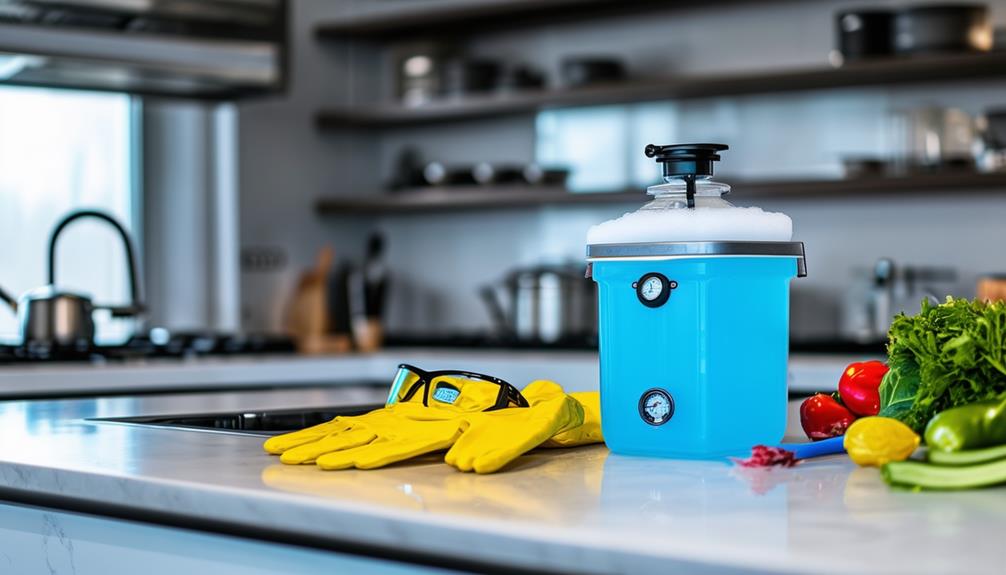
When storing liquid nitrogen, use well-insulated containers to maintain the correct temperature and minimize evaporation. Ensure proper ventilation and safety features to prevent pressure buildup.
Handle these containers carefully to ensure the liquid nitrogen remains effective for your intended use.
Temperature Control Methods
Proper storage of liquid nitrogen is crucial for maintaining its extremely low temperature and ensuring its effectiveness in culinary applications. Using well-insulated containers helps prevent rapid evaporation, extending the longevity and performance of the liquid nitrogen.
Here are three key points to consider for optimal storage:
- Use Quality Insulated Containers: Select containers specifically designed for liquid nitrogen. These containers have superior insulation to maintain the required low temperatures.
- Check Seals Regularly: Ensure the container seals are intact to prevent leaks and minimize evaporation. A well-sealed container keeps the liquid nitrogen colder for longer.
- Store in a Cool, Dry Place: Keeping your insulated container in a cool, dry environment helps maintain the low temperature and prolongs the shelf life of the liquid nitrogen.
Ventilation and Safety
Ensuring good ventilation is crucial for the safe use of liquid nitrogen to prevent inert gas asphyxiation. When working with this extremely cold substance, prioritize proper ventilation in your workspace. Liquid nitrogen rapidly evaporates into nitrogen gas, which can displace oxygen in the air, creating a suffocation risk. Therefore, always use liquid nitrogen in well-ventilated areas to mitigate this hazard.
For storage, select insulated and vented containers specifically designed for liquid nitrogen. These containers are built to handle extremely low temperatures and help maintain the liquid state for a few weeks. Never seal these containers tightly, as the expanding gas needs an escape route to prevent pressure buildup and potential explosions.
High-quality storage containers are essential for safety. They should be durable and equipped with proper venting mechanisms. Regularly inspect them for signs of wear or damage, as compromised containers pose significant risks.
Proper storage and ventilation practices aren't just guidelines—they are necessary for maintaining a safe environment when using liquid nitrogen. By following these precautions, you'll reduce risks and ensure a safer experience.
Handling Containers Safely
To handle liquid nitrogen safely, always use well-insulated and vented containers specifically designed for this purpose. These containers prevent rapid evaporation and ensure safe usage. High-quality containers significantly impact how long liquid nitrogen remains effective.
Here are some important tips for handling liquid nitrogen:
- Storage: Store liquid nitrogen in high-quality, well-insulated containers. This not only slows evaporation but also allows for weeks of storage, although it's best used within a few days for optimal performance.
- Ventilation: Ensure your storage container is vented. As liquid nitrogen warms up, it expands rapidly. A sealed container can lead to dangerous pressure buildup and potential explosion.
- Handling Precautions: Use cryogenic gloves and face protection when handling liquid nitrogen. Even well-insulated containers can become extremely cold externally, posing a frostbite risk.
Using Liquid Nitrogen Safely
Using Liquid Nitrogen Safely
Handling liquid nitrogen requires wearing proper protective gear like cryogenic gloves and eye protection. Always ensure you're equipped with a face shield or safety goggles to guard against splashes and potential burns.
Use well-insulated containers for storage to prevent rapid evaporation and associated risks. Never store liquid nitrogen in airtight containers, as pressure buildup can cause explosions. Instead, use containers specifically designed for cryogenic liquids.
Adequate ventilation is crucial to avoid oxygen displacement, which can lead to suffocation. Always work in a well-ventilated area to ensure you aren't exposed to dangerous levels of nitrogen gas.
Avoiding Common Mistakes
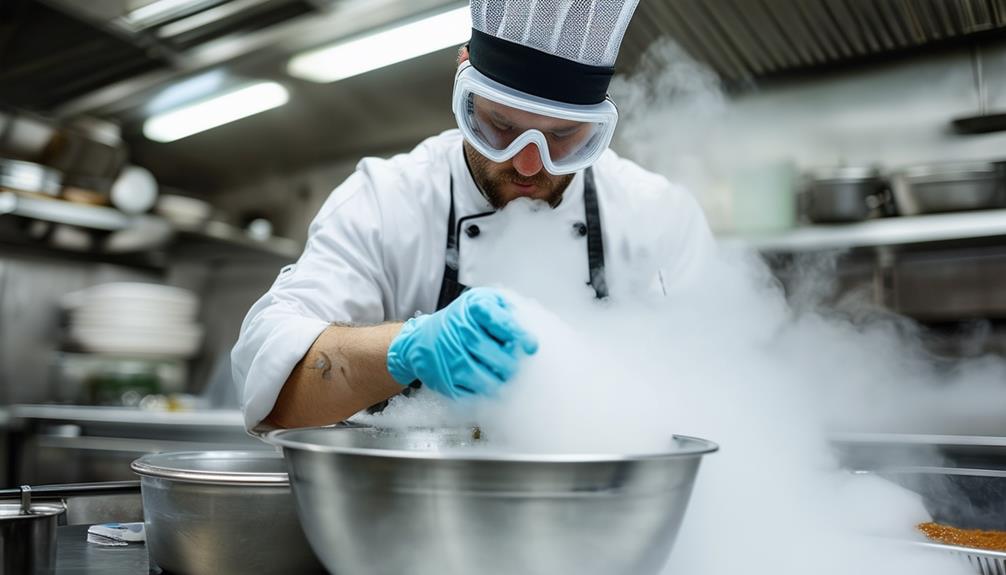
Many common mistakes with liquid nitrogen can be easily avoided with a few simple precautions. First and foremost, always ensure proper ventilation in your workspace. Liquid nitrogen can displace oxygen, leading to inert gas asphyxiation. A well-ventilated area helps maintain adequate oxygen levels, keeping you safe.
Next, never seal liquid nitrogen in a container. As it warms, liquid nitrogen rapidly expands, and a sealed container can lead to dangerous explosions. Always use containers specifically designed for cryogenic materials to prevent accidents.
Lastly, personal safety gear is essential. Use cryogenic gloves to prevent frostbite, and wear safety glasses to protect your eyes from splashes. Liquid nitrogen can cause severe burns and eye injuries if it comes into contact with your skin or eyes.
Here's a simple checklist to avoid common mistakes:
- Ventilation: Always work in a well-ventilated area to prevent gas buildup.
- Proper Containers: Never seal liquid nitrogen in an airtight container.
- Safety Gear: Use cryogenic gloves and safety glasses to protect yourself.
Culinary Applications
After taking the necessary precautions, you can delve into the fascinating culinary applications of liquid nitrogen. This extraordinary substance can rapidly freeze ingredients at -321 degrees Fahrenheit, preserving their structure and creating unique textures.
One of the most popular applications is making ice cream. Liquid nitrogen allows for a smoother, creamier texture compared to traditional methods, as the rapid freezing process prevents the formation of large ice crystals, resulting in a superior dessert.
Beyond ice cream, liquid nitrogen unlocks a myriad of culinary possibilities. Since the 1990s, chefs have employed it to enhance both desserts and savory dishes. For instance, you can freeze fruits to achieve a delightful crunch or create perfectly shaped hamburger patties by quickly freezing the meat.
Delicate items like foie gras benefit from this swift freezing process, maintaining their texture and flavor without the risk of overcooking.
Liquid nitrogen is a versatile tool in modernist cuisine and molecular gastronomy. It reduces cooking times and enables inventive presentations and textures.
Whether you're an adventurous home cook or a professional chef, liquid nitrogen offers endless opportunities for creativity in the kitchen.
Health Considerations
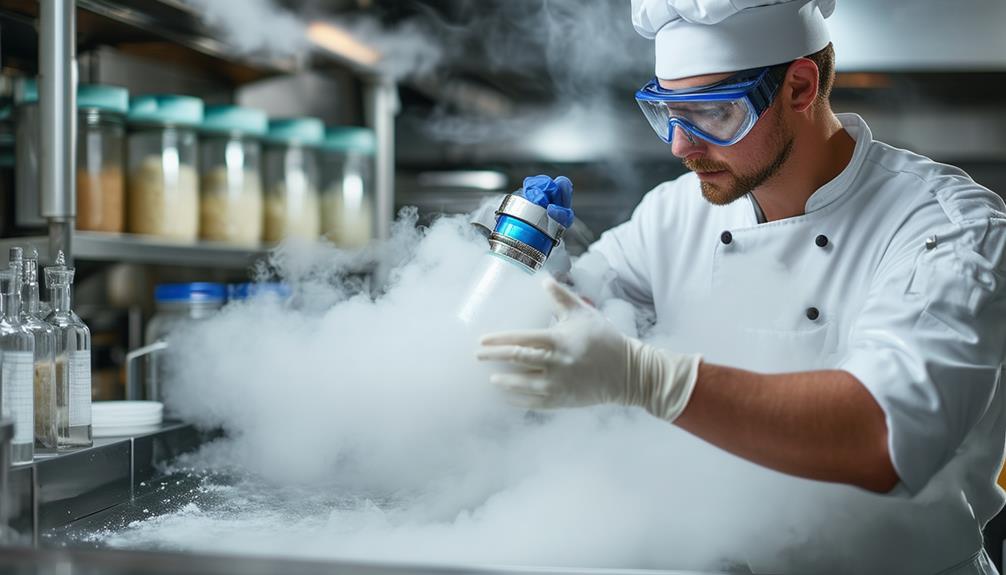
Ensuring the safe use of liquid nitrogen in your kitchen is crucial to prevent severe injuries and health risks. Ingesting liquid nitrogen can cause significant damage to your mouth, throat, and stomach due to its extremely low temperature. To mitigate these dangers, always ensure that liquid nitrogen has fully evaporated from your food before serving. The FDA underscores the importance of complete evaporation for safety.
When handling liquid nitrogen, adhere to these key safety measures:
- Wear protective clothing: Use gloves, goggles, and aprons to protect yourself from accidental splashes or spills. Even small amounts of liquid nitrogen can cause frostbite upon contact.
- Store in well-insulated containers: Proper storage is essential to maintain safety. Ensure that liquid nitrogen is kept in suitable, well-insulated containers to prevent leaks or accidental exposure.
- Work in well-ventilated areas: Liquid nitrogen can displace oxygen in the air, posing a suffocation risk. Always use it in a space with good ventilation to avoid respiratory issues.
Post-Use Clean-Up
After ensuring the safe use of liquid nitrogen, it's essential to follow proper post-use clean-up procedures to maintain a safe cooking environment. Begin by immediately cleaning up any spills using absorbent materials. This step is crucial to prevent accidents and mitigate potential hazards related to residual liquid nitrogen.
Dispose of liquid nitrogen containers with caution, adhering to recommended guidelines and safety protocols. Never discard these containers in regular trash, as improper disposal can lead to dangerous situations.
Thoroughly clean and dry all equipment used with liquid nitrogen after each use. Residual nitrogen can compromise the safety and functionality of your tools, so regular inspection and maintenance are vital.
Additionally, routinely check storage areas for any leaks or damage. Compromised storage can pose significant risks, making regular inspections a necessary part of your post-use clean-up routine.
Tips for Beginners

For beginners, starting with simple recipes like quick ice creams can help you get comfortable using liquid nitrogen in your culinary experiments. This method rapidly freezes food, creating unique textures, but safety is paramount.
Key Tips for Using Liquid Nitrogen:
- Safety First: Always wear cryogenic gloves and safety glasses. Liquid nitrogen is extremely cold and can cause severe injuries upon contact with skin or eyes.
- Proper Storage: Store liquid nitrogen in a well-insulated container to maintain its temperature and prevent rapid evaporation. However, never seal the container, as liquid nitrogen expands when warmed, causing dangerous pressure build-up and potential explosions.
- Ventilation: Use liquid nitrogen in a well-ventilated area. It can displace oxygen in the air, posing a suffocation risk. Good ventilation ensures the air remains safe to breathe.
Conclusion
In conclusion, cooking with liquid nitrogen can be an exciting culinary adventure when safety is a priority. Always wear protective gear, store liquid nitrogen properly, and handle it with care.
Begin with simple recipes and strictly adhere to safety guidelines to prevent accidents. Ensure your workspace is well-ventilated and remain vigilant throughout the process.
By taking these precautions seriously, you can safely explore the unique culinary possibilities that liquid nitrogen offers. Remember, a safe chef is a successful chef, so prioritize safety and enjoy experimenting!




